Etsy Shopify integration – Maximize Your Success with Both Platforms
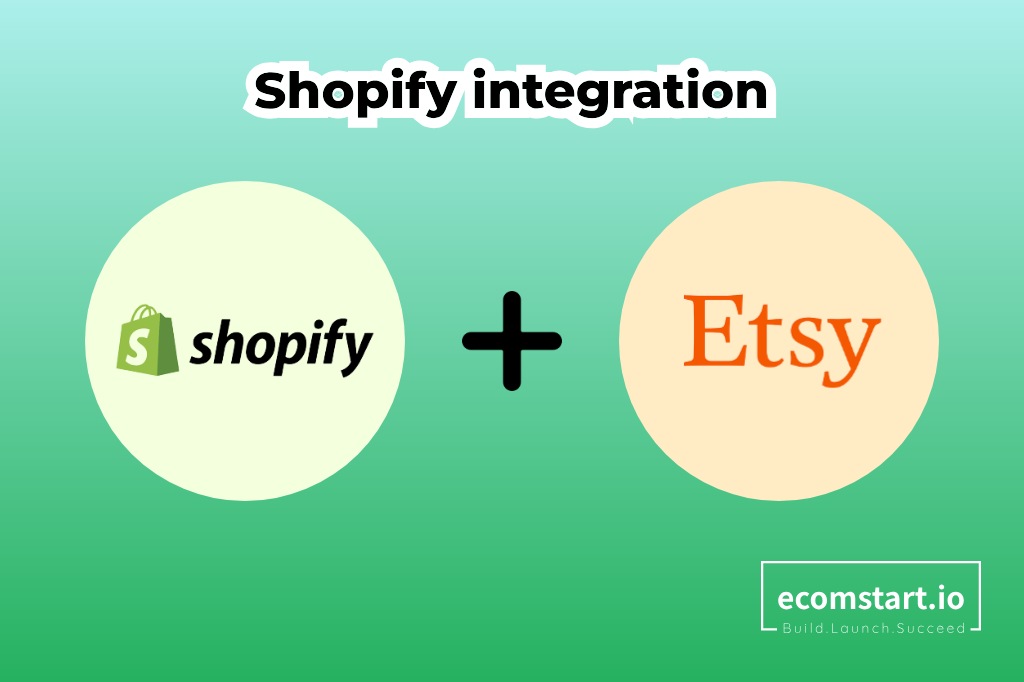
Etsy and Shopify are both powerful eCommerce platforms that can help businesses of all sizes succeed. If your business plans to run on both, it is a must to research and proceed with Etsy Shopify integration.
This article will show you how to run Shopify and Etsy integration seamlessly with some helpful tips to gain profits for your business on these platforms.
Let’s check it out!
1. Etsy Shopify integration? Why integrate?
Both Etsy and Shopify are online platforms for eCommerce businesses, but there are essential differences between a marketplace and a self-hosted platform. You can take a look to get an overview of key characteristics of them:
| Features | Etsy | Shopify |
| Platform Type | Marketplace | Self-hosted platform |
| Branding Control | Limited; branding built around Etsy | Full control over design and branding |
| Customization Features | Limited; themes and variations | Highly customizable; themes, apps, and code editing |
| Marketing Tools | Built-in Etsy marketplace exposure | Wide range of marketing tools and integrations |
| Fees | Listing fees ($0.20 per item) + Transaction fees (6.5%) | Monthly plan fees ($9-$299) + Transaction fees (0.5%-2%) |
| Technical Skills Required | Minimal | Beginner-friendly, but more technical than Etsy |
| Suitable For | Individual sellers, startups, niche products | Established businesses, brands, diverse product range |
| Pros | – Easy to use – Built-in audience – Lower upfront costs | – Full control – High scalability – Multiple payment options |
| Cons | – Limited customization – Higher transaction fees – Less control | – Higher upfront costs – More technical – No built-in audience |
Then why do you need Etsy Shopify integration?
Let’s imagine, you have an Etsy shop about handmade goods running smoothly for several months. You recently wanted to expand your audience base and business size, so you decided to build a Shopify website.
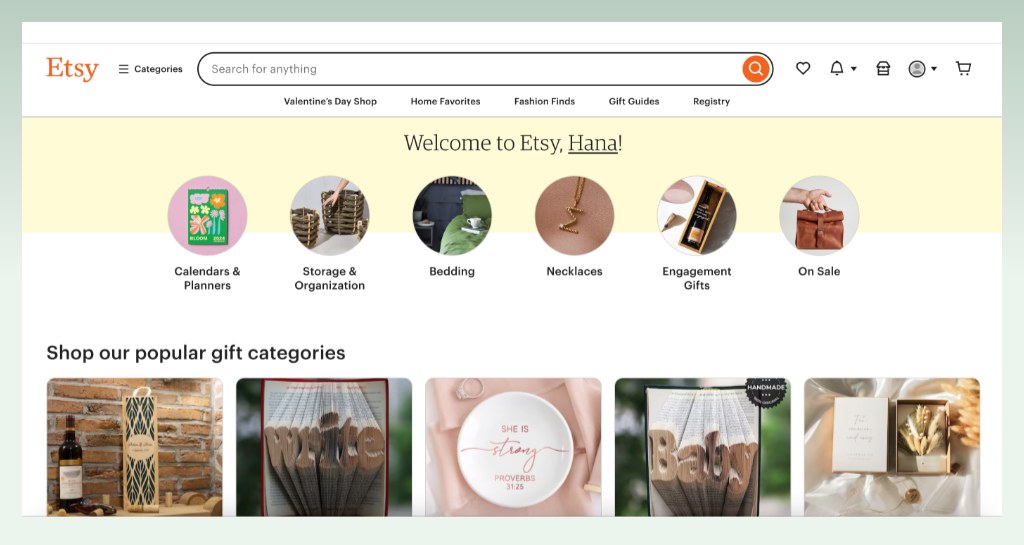
And the problem comes up.
- How to manage all orders from both platforms within a single interface to save time?
- How to update product listings and pricing simultaneously on both platforms to save efforts?
- How to synchronize your inventory across both platforms in real time, preventing overselling and simplifying order fulfillment?
Shopify and Etsy integration will help you sort out all these questions.
If you are planning to run your online business on both Etsy and Shopify and still wonder “Does Etsy integrate with Shopify”, then the answer is yes, Shopify can integrate seamlessly with Etsy.
Now, let’s go into detail on how to integrate Shopify with Etsy!
2. How to integrate your Etsy store and Shopify store?
2.1. Choose an integration app on the Shopify App Store
When you search the keywords Etsy integration on the Shopify App Store, you will see various options for potential integration apps. Depending on the ratings and reviews collected from Shopify users, there are several popular apps to integrate an Etsy shop and a Shopify website that you can take a look at.
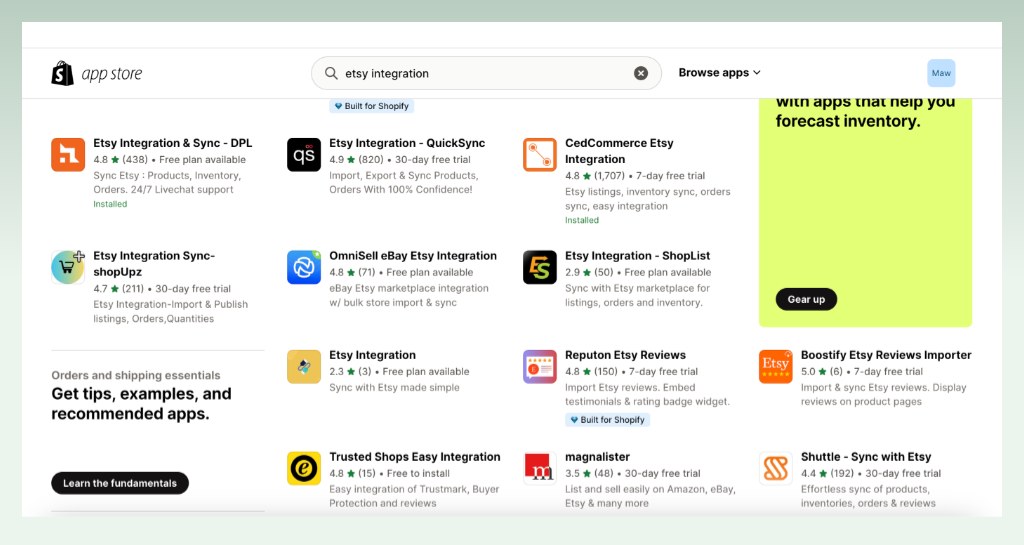
Before diving deeper into the detailed introduction about some specific integration apps, let’s check out some key factors and questions.
| Functionality | Sync capabilities: What data does the app synchronize between platforms? Does it handle inventory, orders, listings, promotions, etc.? |
| Automation: Does the app offer automation features like automatic order fulfillment, shipping label generation, or email notifications? | |
| Customization: Can you customize how the app works to fit your specific needs and workflow? | |
| Additional features: Does the app offer any additional features, like marketing tools, reporting, or advanced inventory management? | |
| Pricing | App cost: Does the app have a one-time fee, a monthly subscription, or usage-based fees? |
| Transaction fees: Does the app charge any additional transaction fees on top of the standard Etsy and Shopify fees? | |
| Free trial: Does the app offer a free trial so you can try it before you buy? | |
| Ease of Use & Support | User interface: Is the app’s interface user-friendly and intuitive? |
| Documentation: Does the app provide you with detailed and step-by-step tutorials? | |
| Customer support: Does the app offer good customer support in case you need help? | |
| Integrations: Does the app integrate with any other apps or services you use? | |
| Reviews | Read reviews: What do other users say about the app? Are they happy with its functionality, support, and value? |
| Brand reputation: Consider the reputation of the app developer and their track record with other integrations. |
Based on these factors, we can get an overview of the essential differences between some popular integration apps, including Etsy Integration ‑ QuickSync, Etsy Integration & Sync ‑ DPL, and CedCommerce Etsy Integration.
| Etsy Integration ‑ QuickSync | Etsy Integration & Sync ‑ DPL | CedCommerce Etsy Integration | |
| Ratings & Review | 4.9 ☆ (800+ reviews) | 4.8 ☆ (430+ reviews) | 4.8 ☆ (1700+ reviews) |
| Free plan | No | Yes | No |
| Free trial | 30-day free trial | 7-day free trial | 7-day free trial |
| Paid plans | Gold plan: $29/month | – Growth: $19.99/month – Explorer: $29.99/month – VIP: $59.99/month | – Starter: $19/month – Basic: $39/month – Standard: $59/month – Advanced: $69/month |
| Transaction fees | No | Etsy charges $0.20 per Listing | Etsy charges $0.20 per Listing |
| Functionality | Basic sync of products, orders, inventory | More advanced sync: variations, shipping profiles, promotions | Extensive sync: custom attributes, production partners, shop sections |
| Pros | – Easy to use – Seamless syncing- Responsive customer support- Long free trial- No transaction fees | – Free plan available – Various options for plans – User-friendly interface interface – Automation options | – Various options for plans – Extensive features – Bulk editing and automatic syncing – 24/7 support |
| Cons | – Limited syncing products – Limited features – Limited choice in plans | – Transaction fees – Limited advanced features – Occasional syncing issues (mentioned on Shopify reviews) | – Transaction fees – No free plan – Steep learning curve for advanced features |
Depending on your individual needs and circumstances, you can choose a perfect fit for your integration process between Shopify and Etsy.
2.2. Install a Shopify Etsy integration app
After making the last decision, just go to the Shopify App Store and install the integration app you choose.
You can click the “Install” button here, log in to your Shopify account, and finish the installation process.

And now, it’s high time to decide which plan you want to give a try. Don’t miss out on the free trial that the app offers, it will give you a chance to experience all the powerful features and functions of that app before purchasing it.
2.3. Connect and configure Etsy shop
The next step is to connect your Etsy shop with the app. This connection will allow you to list your products on Etsy, sync their inventories, manage orders, etc. in real time.
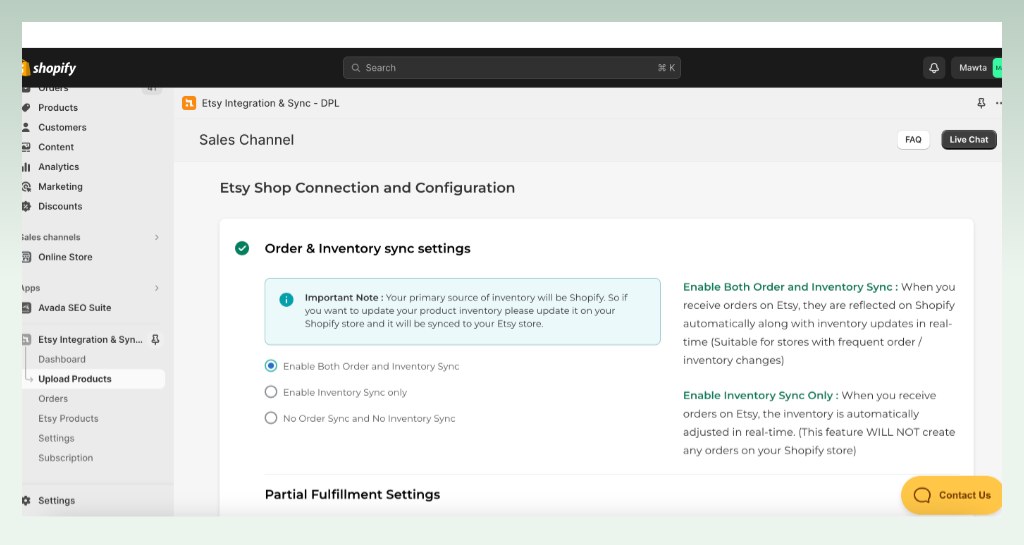
You need to choose and decide which data from your Etsy shop will be synced to your Shopify store, including order, inventory, fulfillment settings, and product information (product title, description, price, tags, images, etc.).
After clicking the connect button on the Shopify integration app, Etsy will require you to confirm once again that you understand and agree to share your Etsy data with a third-party app.

And don’t worry, you can revoke this access at any time by visiting Your Account setting on Etsy.
2.4. Sync your products
Almost all Etsy Shopify integration apps will allow you to upload your Etsy products to the Shopify website and vice versa.
Some apps will give you the option to fetch your products into Etsy or Shopify in bulk, which saves you time and effort. Your products will be uploaded to Etsy with all the details from Shopify. Common fields include:
- Product Title
- Product Description
- Product price
- Product images
- Product variations (e.g., size, color)
- Inventory levels
- Shipping options
And any new products you add to this Shopify collection will be automatically updated on the app and uploaded to Etsy.
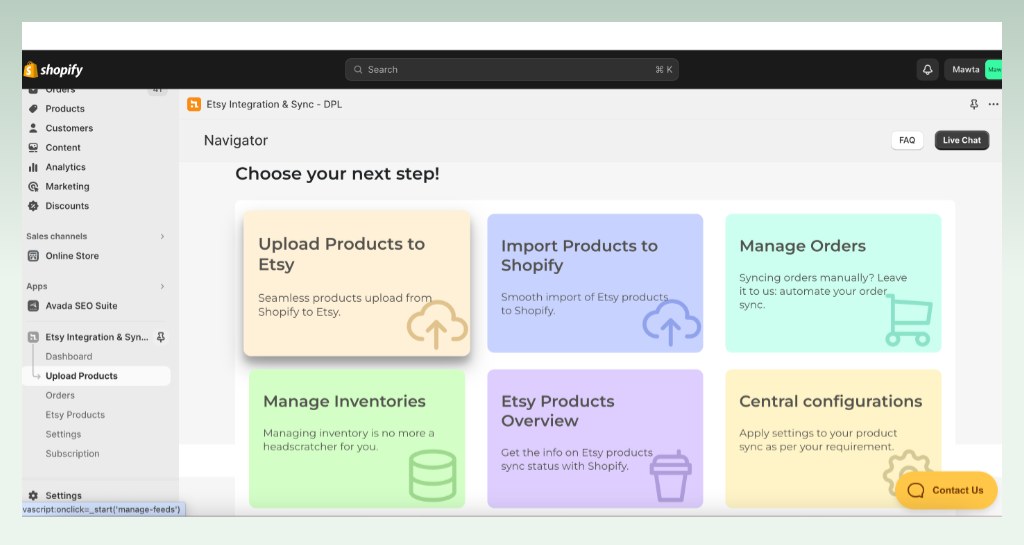
The product updates, orders, and inventory will be regularly synchronized between Shopify and Etsy for the products that you linked to prevent overselling.
2.5. Sync your orders
The order syncing feature allows you to sync orders from Etsy to Shopify and update the tracking number to your Etsy orders directly from Shopfy’s order section. This streamlines order management and shipping processes.

Normally, the syncing process can transfer:
- Order ID
- Customer name and address
- Order items
- Shipping method
- Payment information
In addition, depending on the app setup, you can receive alerts for new orders placed on either platform, ensuring prompt order processing and customer communication.
2.6. Sync your inventory
First of all, you can check the documentation or connect with the customer support of the integration app to confirm that the source of the product will be Shopify once connecting the Shopify and Etsy products. It means if you’re connecting already existing products, the quantity from Shopify will overwrite the quantity on Etsy.
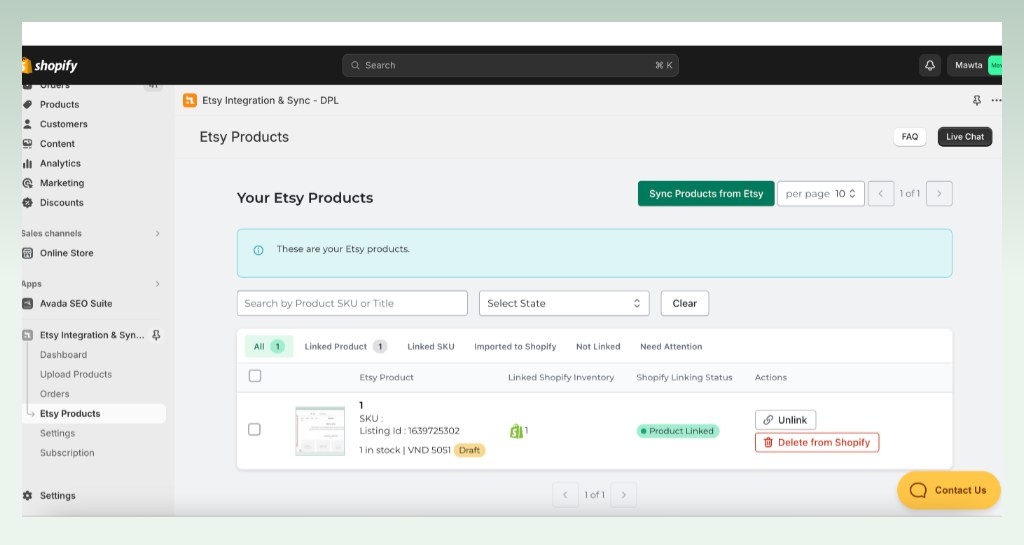
Depending on the features of each app and your strategies for inventory management, you can choose to track inventory levels collectively for accurate stock visibility. Besides, with some apps, you can maintain separate inventories for each platform, potentially helpful for different product offerings or fulfillment strategies.
You should work with an integration app that offers real-time inventory syncing to enable a shared inventory pool and prevent overselling.
Keep in mind that the app should send notifications to you when inventory levels reach predefined thresholds. It will help you restock your products proactively and avoid fulfillment issues.
2.7. Test and refine
It is essential to carefully review synced data on both Etsy and Shopify. You need to make sure that product listings, inventory levels, and order information match expectations. Your data should be transferred and displayed completely and accurately.
If you encounter any problems like missing or incorrect product information, inventory level mismatches, or order processing errors, don’t hesitate to contact the customer support team to seek help.
Also, we highly recommend you regularly access the integration app’s dashboard to track sync activity (successes, failures, pending items). Also, make sure that you will not miss out on any notifications from the integration app to avoid potential issues.
3. Tips for running a successful store on both Etsy and Shopify
3.1. Define your goal
What is your goal? Are you looking to reach a wider audience, increase sales, or experiment with different platforms?
Identifying your goals clearly will guide your smart decisions and effective resource allocation.
3.2. Choose the right product
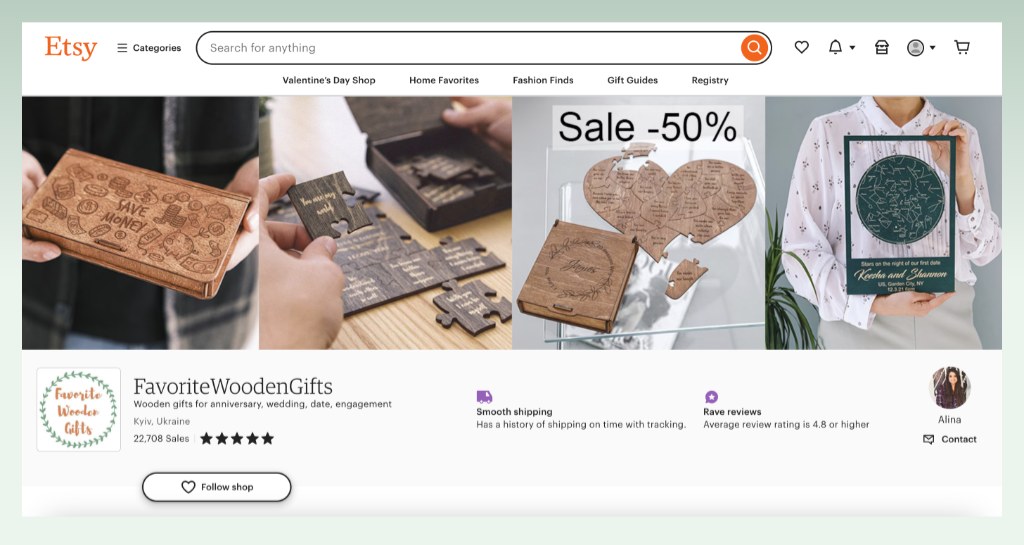
Is it better to sell on Etsy or Shopify?
Before beginning your journey into the business world, instead of struggling with this question, why don’t you choose products that can do equally well on both platforms?
To be more specific, Etsy is a marketplace focusing on unique, handcrafted items. Therefore, if you are planning to get started with a creative business, just go for it!
> You can check out some unique art business ideas here with us!
And a small note that competition, target audience, and platform fees are the important factors to be considered when seeking your products.
3.3. Choose an Etsy Shopify integration app
A helpful integration app can automate data syncing between platforms, saving you time and effort. It will help the operational process of your business run smoothly and effectively in both Etsy and Shopify.
Provide excellent customer service
During the Etsy to Shopify integration, make sure that you can offer prompt and helpful customer service on both platforms. Responding to inquiries and resolving issues efficiently will be a game-changer tip for your business to build trust and loyalty.

3.4. Track your performance
Key metrics of your business like sales, traffic, and conversions on both platforms should be updated in real time and monitored regularly. It is your to-do task to analyze data to identify areas for improvement and optimize your approach.
4. Examples of successful Etsy and Shopify stores
4.1. Hiut Denim Co.

This Welsh jeans brand uses its Shopify store for wholesale and international sales while optimizing its Etsy shop for direct-to-consumer sales and connecting with a more craft-focused audience. Hiut Denim Co. is an appealing choice for customers seeking a unique experience.
4.2. The Outrage

This home decor brand uses Etsy for limited-edition and vintage finds, catering to a collector audience. Whereas, their Shopify store focuses on their regular product lines and offers a more streamlined shopping experience, highlighting their hand-picked selection and personal touch.
4.3. Adored Vintage

Adored Vintage is a vintage jewelry shop with unique pieces on Etsy, offering exclusive designs and connecting with a niche audience. In addition, a broader range of vintage accessories is shown on their Shopify online store to provide a more modern browsing experience.
5. Conclusion
To sum up, we hope that this article provides you with a detailed instruction on how to proceed with Etsy integration with Shopify. Running a successful store on both Etsy and Shopify can be challenging but incredibly rewarding.
And it is worth a try, right?
Let eComStart become a part of your journey to conquer the business world. We are here with step-by-step guides, helpful insights, and valuable tips that you will not want to miss out on!
6. FAQs


